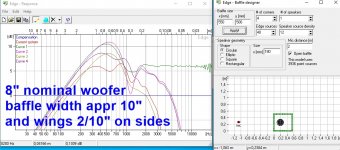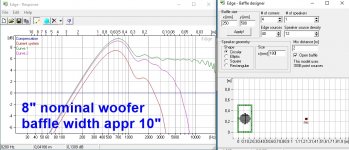You're doing it right. The distance to the edge of the baffle is near a half wavelength.
The limitation is how distinct it looks due to the theoretical point source. In a way, this is more of a feature than a disadvantage when designing. With a little more work it is possible to set up a dipole source with a finite length.
I've also played with the settings and found that there's a difference, but it isn't clear what is what.
The limitation is how distinct it looks due to the theoretical point source. In a way, this is more of a feature than a disadvantage when designing. With a little more work it is possible to set up a dipole source with a finite length.
I've also played with the settings and found that there's a difference, but it isn't clear what is what.
Right, I've discovered the point sources can be moved closer together, it's damn fiddly, I moved one away from the wall and the reflection and null increased, as you say, tricky to know what's what, and it makes you 

A link to measurements by Danny has been posted on audiocircle but I can't see them for some reason.
I visited Audiocirle too SW-12-16FR in U-Frame
Here is the speaker, backside wings are not showing well. The woofer is 8" and there is also Neo8


dip and peak at 3,5/5kHz is woofer's cone resonance!
It is hard to see in the picture but there is a short wing and a long wing on each side angled out 100 degrees from the surface of the front baffle. All of these measurements show the response of the 8" woofer before any crossover is added. The grey line in the background is the response of the 8" woofer with no side wings. It is shown for reference with all of the measurements.
The basic problem with Richie's design is that both woofer and tweeter share same baffle (width). Pure dipole radiation happens only below the dipole axial null, and directivity above it is a mixture of edge diffraction effects and radiator's directivity (based on it's diameter and membrane profile)
So, these sidewings introduce edge reflections ripples that Richie is trying to minimize for on-axis response only. Looks like he doesn't understand (dipole open baffle) acoustics at all.
Here Edge sims of 10" flat bafffle and with wings.
Here is the speaker, backside wings are not showing well. The woofer is 8" and there is also Neo8


dip and peak at 3,5/5kHz is woofer's cone resonance!
It is hard to see in the picture but there is a short wing and a long wing on each side angled out 100 degrees from the surface of the front baffle. All of these measurements show the response of the 8" woofer before any crossover is added. The grey line in the background is the response of the 8" woofer with no side wings. It is shown for reference with all of the measurements.
The basic problem with Richie's design is that both woofer and tweeter share same baffle (width). Pure dipole radiation happens only below the dipole axial null, and directivity above it is a mixture of edge diffraction effects and radiator's directivity (based on it's diameter and membrane profile)
So, these sidewings introduce edge reflections ripples that Richie is trying to minimize for on-axis response only. Looks like he doesn't understand (dipole open baffle) acoustics at all.
Here Edge sims of 10" flat bafffle and with wings.
Attachments
Last edited:
Thanks, I don't know why I can't see any pics on that site, anyway, he appears shy about the off axis response there too.
Last edited:
Danny's going to take some measurements, I'm glad he's responded, the L-frame idea may not be perfect but could be useful.
- Home
- Loudspeakers
- Multi-Way
- What is the polar response of "L-frame" OB speakers

